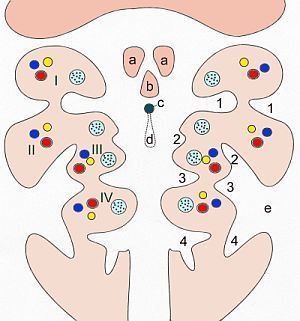Carnegie stage 10 Code TE E5.4.2.0.0.1.1 | Latin sacci pharyngei | |
 | ||
In the embryonic development of vertebrates, pharyngeal pouches form on the endodermal side between the pharyngeal arches. The pharyngeal grooves (or clefts) form the lateral ectodermal surface of the neck region to separate the arches.
Contents
The pouches line up with the clefts, and these thin segments become gills in fish.
First pouch
The endoderm lines the future auditory tube (Pharyngotympanic Eustachian tube), middle ear, mastoid antrum, and inner layer of the tympanic membrane. Derivatives of this pouch are supplied by Mandibular nerve.
Second pouch
Third pouch
Fourth pouch
Derivatives include:
Fifth pouch
Sixth pouch
References
Pharyngeal pouch (embryology) Wikipedia(Text) CC BY-SA
